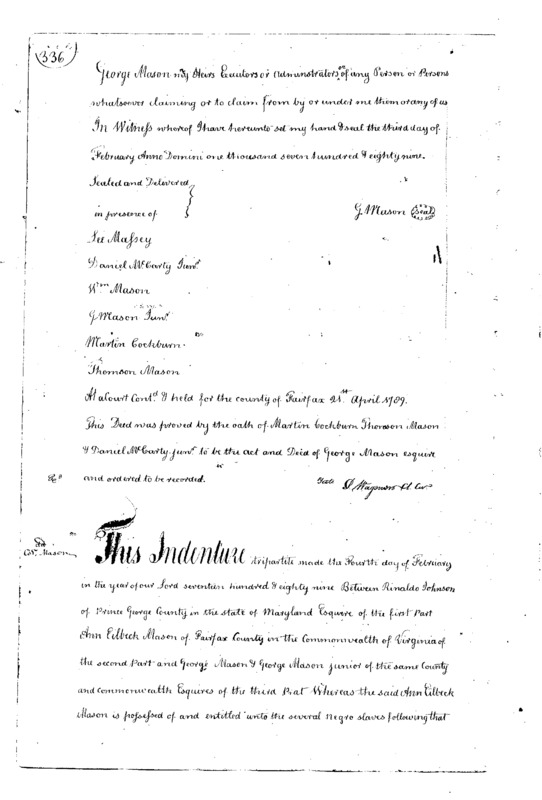George Mason, the Enslaver
Since there are no extant plantation account books for George Mason, it is difficult to know exactly how many, slaves Mason purchased or where he may have purchased them from over the course of his lifetime. By 1753 he likely purchased slaves to support the development of his Mason Neck properties. This is when John Mercer and George Mason IV’s brother Thompson Mason, among others in the region, expanded their slave holdings to develop their lands in the Northern Neck. Even if he did not purchase slaves from Africa Mason clearly benefited from the natural increase from amongst people he enslaved which occurred during this period. We can see evidence of this in the Fairfax County court records by observing the practice known as adjudgment. Adjudgment provided that an owner was required to present newly imported slaves to the court for the purpose of “ascertaining the age of children imported into this colony.” In this process these children would be physically inspected by judges and assigned a “true age” so that “every such child shall be immediately tithable, although not sixteen years of age.” George Mason brought seven children to court in August 1758 for this purpose. The record indicates that “several Negro’s belonging to George Mason are adjudged as followeth (Viz!), Oronoko twelve years old, Syphax Eleven years old, Juba, Eleven years old, Kate ten years old, Beck nine years old, Jenny Eight years old and Agnis Eight years old.” It is unclear if these were newly imported slaves or simply enslaved children who were brought to court to be assessed for tax purposes but there are no other recordings of adjudgments for Mason’s enslaved property after this date. All seven of the aforenamed enslaved children were later identified in Mason’s 1773 Last Will and Testament as gifts to his heirs to be distributed as part of his legacy to his children. The only known purchase of a slave by George Mason is identified in a 1767 record from John Glassford & Company’s account book where Mason was charged “£56.15 ‘to ship Jenny for a Negro fellow sold to you.’” It seems unlikely that he would have been involved in buying large numbers of slaves since, perhaps because of Mercers’ economic woes, he seemed averse to credit in many public pronouncements and ultimately was one of the few planters to die free from debts.[1]
[1] Terry K. Dunn, Among His Slaves: George Mason, Slavery at Gunston Hall, and the Idealism of the American Revolution (Alexandria, VA: Commonwealth Books of Virginia, 2017), 64; Allan Kulikoff, “A ‘Prolifick’ People: Black Population Growth in the Chesapeake Colonies, 1700-1790,” Southern Studies: An Interdisciplinary Journal of the South 16, no. 4 (October 1977): 391–428; William Waller Hening, “Chapter XXI: An Act concerning Tithables,” Statutes at Large; Being a Collection of All the Laws of Virginia, from the First Session of the Legislature (New York: R&W.&G. Bartow), 41; “Adjudgment of Negros of George Mason,” 21 August 1758, Fairfax County Court Minute Book 1749, 436; This is clearly a problem since George Mason held over one hundred people in slavery and this could only happen by natural increase or by importation. See Jackson T. Main, “The One Hundred,” The William and Mary Quarterly 11, no. 3 (1954): 354–84; Terry K. Dunn, Among His Slaves: George Mason, Slavery at Gunston Hall, and the Idealism of the American Revolution (Alexandria, VA: Commonwealth Books of Virginia, 2017), 64.
